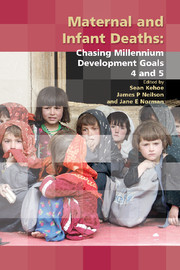Book contents
- Frontmatter
- Contents
- Participants
- Declaration of personal interests
- Preface
- The Millennium Development Goals
- SECTION 1 THE SIZE OF THE PROBLEM
- 1 The geography of maternal death
- 2 Delivering on neonatal survival to accelerate progress for Millennium Development Goal 4
- 3 Beyond the Numbers: reviewing maternal deaths and disabilities to make pregnancy safer
- 4 Human resource challenges
- SECTION 2 CLINICAL PROBLEMS AND SOLUTIONS – MATERNAL
- SECTION 3 CLINICAL PROBLEMS AND SOLUTIONS – NEONATAL
- SECTION 4 TRAINING AND DEVELOPMENT
- SECTION 5 SPECIFIC CHALLENGES IN SPECIFIC COUNTRIES
- SECTION 6 CONSENSUS VIEWS
- Index
4 - Human resource challenges
from SECTION 1 - THE SIZE OF THE PROBLEM
Published online by Cambridge University Press: 05 February 2014
- Frontmatter
- Contents
- Participants
- Declaration of personal interests
- Preface
- The Millennium Development Goals
- SECTION 1 THE SIZE OF THE PROBLEM
- 1 The geography of maternal death
- 2 Delivering on neonatal survival to accelerate progress for Millennium Development Goal 4
- 3 Beyond the Numbers: reviewing maternal deaths and disabilities to make pregnancy safer
- 4 Human resource challenges
- SECTION 2 CLINICAL PROBLEMS AND SOLUTIONS – MATERNAL
- SECTION 3 CLINICAL PROBLEMS AND SOLUTIONS – NEONATAL
- SECTION 4 TRAINING AND DEVELOPMENT
- SECTION 5 SPECIFIC CHALLENGES IN SPECIFIC COUNTRIES
- SECTION 6 CONSENSUS VIEWS
- Index
Summary
Introduction
It has become increasingly clear that one of the key solutions to the problem of maternal and infant mortality is the provision of sufficient skilled, up-to-date and empathic birth attendants when and where women need them, in the context of a system that permits rapid escalation of care and emergency treatment where this is necessary. There is almost universal agreement on this principle, even if there is intense debate on the implications for the nature and location of maternity services provision. Despite the rhetorical consensus, in 2006 the World Health Organization (WHO) noted that 57 countries had a severe lack of healthcare workers in general, including maternity care workers.1 In 2008, the Kampala Declaration on ‘health workers for all and all for health workers’ announced that:
Everyone committed to this agenda shares the vision that ‘all people, everywhere, shall have access to a skilled, motivated and facilitated health worker within a robust health system’.
At the 2006 World Health Assembly, WHO issued Resolution WHA59.23, which called for rapid scaling up of health workforce production, and WHA59.27, which called for the strengthening of nursing and midwifery globally. In 2009, the WHO Making Pregnancy Safer report estimated that there was a 50% shortfall on the 700000 midwives that were needed worldwide and that 47000 doctors with obstetric skills were still required, particularly in rural areas. This chapter deals with some of the issues to be addressed if the Resolutions are to be met.
- Type
- Chapter
- Information
- Maternal and Infant DeathsChasing Millennium Development Goals 4 and 5, pp. 61 - 82Publisher: Cambridge University PressPrint publication year: 2010

